

© David Hallam - 2025
|
Beeston to Australia – With a Lot At Both Ends!
The Surplice family certainly made their mark on Nottingham and its surrounding communities - particulaly Beeston, Lenton and Wollaton - as builders and surveyors as well as farmers,
publicans and other contributors to the community. But, for one branch in particular, that of William Surplice and his sons - that contribution was to be extended to assisting the development of Australia in
its goldrush years and beyond. Here we tell this story of this remarkable family. |
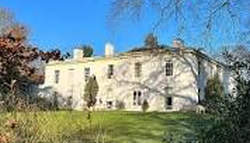 William Surplice was born, probably in Nottingham, in 1797, part of the latest of several generations of the family who had made their mark in the building and associated engineering
fields in what had become a fast-moving opportunity as the needs of the emerging industrial scene – and the somewhat grandiose needs of those who led it – became widespread. His father, also William
Surplice (1770-1830) was born and died in Lenton and traded successfully as a stone and marble mason from premises on Clumber Street in Nottingham. By then, the building business had become a family tradition
with a firm foundation, with Thomas Surplice (1761-1824), the older William’s brother and also a lifetime Lenton resident, having made his mark as builder, mason and surveyor – notably of the then fast-emerging
railway network – and who, towards the end of the 18th century, is believed to have built the later section of the Wollaton Park wall around the Sutton Passeys enclosure, a clear connection between industry and
the aristocracy that had then developed and was there to benefit from by those with the abilities, ambition and social skills – and the several generations of the Surplice family were certainly part of that,
something that was reflected in their advertising that often addressed the “Nobility and Gentry”.
William Surplice was born, probably in Nottingham, in 1797, part of the latest of several generations of the family who had made their mark in the building and associated engineering
fields in what had become a fast-moving opportunity as the needs of the emerging industrial scene – and the somewhat grandiose needs of those who led it – became widespread. His father, also William
Surplice (1770-1830) was born and died in Lenton and traded successfully as a stone and marble mason from premises on Clumber Street in Nottingham. By then, the building business had become a family tradition
with a firm foundation, with Thomas Surplice (1761-1824), the older William’s brother and also a lifetime Lenton resident, having made his mark as builder, mason and surveyor – notably of the then fast-emerging
railway network – and who, towards the end of the 18th century, is believed to have built the later section of the Wollaton Park wall around the Sutton Passeys enclosure, a clear connection between industry and
the aristocracy that had then developed and was there to benefit from by those with the abilities, ambition and social skills – and the several generations of the Surplice family were certainly part of that,
something that was reflected in their advertising that often addressed the “Nobility and Gentry”.
The young William certainly continued in that direction, having been apprenticed to his father's cousin, the highly succesful architect and builder, William Stretton and, in May 1818, marrying Elizabeth Lowe, the
elder daughter of Joseph Hurst Lowe – who had died in the previous year - and his wife Elizabeth (née Longstaff), who lived at Highfield House (See above left) that had been built, in 1797, for his father, Joseph Hurst Lowe
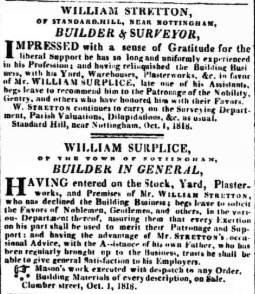 (1737-1810), a Nottingham draper on Long Row and three-times Mayor of that borough. The house stood in more than 150 acres of beautifully landscaped and cultivated surroundings that were eventually to become a large
part of the University campus and associated public park, after its acquisition by its benefactor, Jessie Boot, in 1919. In October 1818, he took over William Stretton's building business (See right).
(1737-1810), a Nottingham draper on Long Row and three-times Mayor of that borough. The house stood in more than 150 acres of beautifully landscaped and cultivated surroundings that were eventually to become a large
part of the University campus and associated public park, after its acquisition by its benefactor, Jessie Boot, in 1919. In October 1818, he took over William Stretton's building business (See right).
Since ancient times – as far back as the Domesday Book and before – Beeston and Lenton had been connected, both physically and by family relationships and interests. These connections were evident in Medieval times when
Beeston was connected ecclesiastically to Lenton Priory and some land connections were to survive the Enclosure of 1809 and persisted throughout the 19th century and beyond, before being largely severed by boundary
adjustments and the development of the University and its surrounds. This can be seen in the horizons of members of the Lowe family in Highfield House, positioned as it was adjacent to Cut Through Lane, the footpath to
Nottingham, through Lenton, used by Beeston folk since ancient times and the nearby Beeston Lane which was part of Beeston until relatively recently. We have also seen this in farming and in the licensed trade in
particular, when Lenton-base landlords took over Beeston pubs over the years. Members of both the Lowe and the Surplice families were certainly part of this with some moving to Beeston, some born there and some
developing businesses there. A clear example of this was Edward Joseph Lowe (1825-1900), the son of Alfred Joseph Lowe and therefore the nephew of William Surplice's wife, Elizabeth, née Lowe. At an early age, he
had followed his father's interest in meteorology and, after his marrage in 1849 set up home in Beeston. There. he and his wife lived for a year or two at the large house on the High Road, known as the The Villa, that
then became the home of John Watson, the owner of the Silk Mill. During this time they had built a purpose-designed home at what is now 72 Broadgate, Beeston where they moved to in 1851 and where he continued with his
advanced weather and astronomical observations.
For their part, William Surplice and his wife settled down on Clumber Street in Nottingham and William set about making his name as a builder, architect and surveyor and, as William Stretton had done before him, went on
to design or redesign several local churches and other local landmark buildings. They included a new church at Markham, Notts in 1834, a reorganisation of the interior of St Marys, Nottingham in 1839, a rebuild
of St Stephens, Sneinton in 1838 and a new church in Carrington, Nottingham in 1843 as well as enlargements to the County Gaol in 1833.
The couple went on to have six children before, sadly, in 1830, Elizabeth died. One of the children, Sidney Lowe Surplice, died in 1828, aged two. In 1842, Eliza Adeline, their eldest daughter married, at St Marys,
Nottingham, the then Rector of St Nicholas, Rev Henry Maltby, the son of the late Samuel Maltby who had traded as a wine merchant on Beastmarket Hill. The wedding was described vividly in the local press as “The
bells rang on merry peal on the occasion, and the bridal party was one of the gayest Nottingham has seen for many years”. It was a good start, but it was not to end well. Two daughters were born to the couple
but, sadly, by 1851 the marriage had collapsed with Henry driven to publishing a statement that he was not responsible for her debts, having already provided for her needs. Then, in 1860, their older daughter,
Adeline Kate, then aged 16, having, along with her mother and younger sister, converted to Roman Catholicism, married Louis de Szeliga Zychlinski, who claimed that he was a Baron of the Russian empire amongst
other false claims, and went on to live in France. Sadly, as his claims unravelled, his cruelty to his wife increased, her father had to arrange for the family to rescue her and return her to England, where her
daughter was born in 1861. In November 1862, she was granted a divorce, with costs and custody of their child, on the grounds of her husband’s adultery and cruelty. Adeline died in Paris in 1867, aged only 23 and
her daughter also died there in 1899, aged 37. Her father died, aged 52, in 1869 in Blackheath, Kent. At some point, her sister, Mary Frances, settled in New Zealand where she married Robert William Ewans. She
died in Taranaki in 1935, aged 90. The later life of her mother is unclear.
Having established himself in the community and having already served as a Poor Law Guardian, in 1841, William Surplice decided to offer himself for election on the Borough Council as a Conservative. After a narrow
defeat, he tried again the next year and, this time, was elected. In 1845, he lost his seat on the Council and his position as a Poor Law Guardian in 1846 and did not run again for office.
Now, all his energies were again focussed on his architect’s and surveying business, while discontinuing his building activity and, to assist with the reorganised business, he brought his eldest son, William Henry,
then aged 22, into partnership.
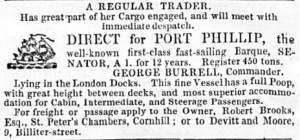 This new arrangement was, however, to be short-lived as, by 1848, William Henry, along with his younger brother Alfred Arthur, then aged 20, had decided to seek a new life in Australia. Accordingly, they left the
London Docks in June 1848 on the ‘Senator’, a 450-ton barque under Captain George Burrell and, after a journey of about 11 weeks, arrived at Port Phillip, in what is now Victoria, Australia. The brothers quickly
settled in Geelong, a newly emerging community, about 50km from Melbourne where they found plenty of opportunities for their experience and enthusiasm.
This new arrangement was, however, to be short-lived as, by 1848, William Henry, along with his younger brother Alfred Arthur, then aged 20, had decided to seek a new life in Australia. Accordingly, they left the
London Docks in June 1848 on the ‘Senator’, a 450-ton barque under Captain George Burrell and, after a journey of about 11 weeks, arrived at Port Phillip, in what is now Victoria, Australia. The brothers quickly
settled in Geelong, a newly emerging community, about 50km from Melbourne where they found plenty of opportunities for their experience and enthusiasm.
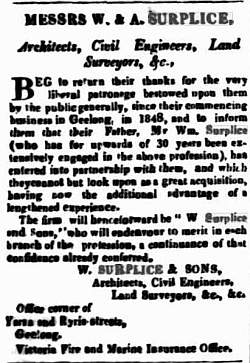 Sadly, back at home in Nottingham, their youngest sister, Agnes Lavinia, had died, aged 18 in September 1848, just before her brothers’ arrival in Australia leaving their father left with just one of his family
at home, Francis Amelia, aged about 28 and unmarried. Also, there was Hannah Unwin, then about 40, who had been a servant to the family for much of the time since the death of William’s wife. Now, with very
encouraging news arriving from his two sons in Australia and so little of his past life intact, William decided to make the move too. So it was that, together with Francis and Hannah. he sailed to join his
sons and arrived in Geelong around the beginning of 1850. He soon agreed that there were plenty of opportunities there for he and his sons and, in June of that year they announced (See Right) that the three of
them had formed a partnership there, to offer their services as architects, civil engineers and surveyors with an office in Geelong. They soon found their skills in demand and were involved in the designing an extension
to Christ Church, the oldest Anglican church in Victoria. Founded in 1843, it had opened originally in 1849, and the enlarged church was consecrated in 1859.
Sadly, back at home in Nottingham, their youngest sister, Agnes Lavinia, had died, aged 18 in September 1848, just before her brothers’ arrival in Australia leaving their father left with just one of his family
at home, Francis Amelia, aged about 28 and unmarried. Also, there was Hannah Unwin, then about 40, who had been a servant to the family for much of the time since the death of William’s wife. Now, with very
encouraging news arriving from his two sons in Australia and so little of his past life intact, William decided to make the move too. So it was that, together with Francis and Hannah. he sailed to join his
sons and arrived in Geelong around the beginning of 1850. He soon agreed that there were plenty of opportunities there for he and his sons and, in June of that year they announced (See Right) that the three of
them had formed a partnership there, to offer their services as architects, civil engineers and surveyors with an office in Geelong. They soon found their skills in demand and were involved in the designing an extension
to Christ Church, the oldest Anglican church in Victoria. Founded in 1843, it had opened originally in 1849, and the enlarged church was consecrated in 1859.
But, in 1851, gold was found in Ballarat, about 85 kilometres away, and they quickly joined in the rush, knowing that there would be a great demand for their skills there and that was soon found to be the case.
Also in that year, William’s personal life progressed when he and Hannah Unwin were married in Ballarat. Sadly, their life was once again hit by tragedy when William’s daughter, Frances Amelia, died in Geelong,
aged 30, in March 1852 and was buried in Geelong Eastern Cemetery.
Despite this tragic setback, the trio quickly turned to providing for the needs of the large number of fortune hunters that were arriving in Ballarat daily. William built the Golden Fleece Hotel on Lydiard Street
which had been transformed from a muddy track to the main street in the first few years of the gold rush and is today the main street, with many historic buildings, that attracts today’s tourists – although the site
of Golden Fleece was, in later years, occupied by the English, Scottish & Australian Bank and recently by the offices of Baird & McGregor and Quality Inn.
Seeing another clear opportunity of this fast growing community, William Henry and his brother Alfred Arthur, opened a store in the goldfields in 1853 which supplied provisions to the military camp as well as to the
growing mining population and, as had been the family focus for many years, they acted swiftly to set up the first Anglican place of worship in Ballarat with the first service held at their store, with a temporary
altar formed by a Union Jack covering a heap of bottles, before more permanent premises could be opened with William Henry as a Churchwarden.
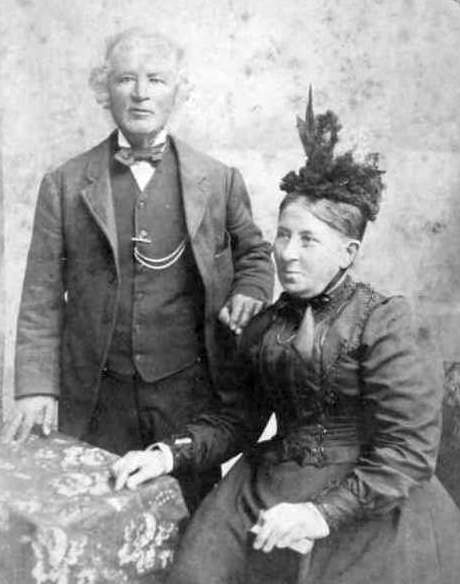  The brothers and their father traded as gold brokers during this frenetic time and William Henry is known to have purchased gold on behalf of the Bank of New South Wales. For 15 years, he was the Government Surveyor
in Ballarat, Chairman of the Roads Board and laid out land surrounding what was known as ‘The Swamp’. He was also a partner in and editor of the Welsh & Surplices Gazette.
The brothers and their father traded as gold brokers during this frenetic time and William Henry is known to have purchased gold on behalf of the Bank of New South Wales. For 15 years, he was the Government Surveyor
in Ballarat, Chairman of the Roads Board and laid out land surrounding what was known as ‘The Swamp’. He was also a partner in and editor of the Welsh & Surplices Gazette.
In December 1856, at Ballarat, William Henry married Julia Ford (Shown left), born in 1840 in London. The couple had a total of nine children, of which six – all male – lived into adulthood. In around the early
1870s, he and his family spend a while in Levuka in Fiji where he was the chief surveyor for the Polynesia Company as well as a government member. They moved to Woollahra, New South Wales, now part of the eastern
suburbs of Sydney, in the mid-1870s.
Alfred Arthur Surplice continued to practice and to prosper as a civil engineer, in Victoria, for many years. Relatively late in his life, when he was in his 50s, he and Annie Mclean, then in her 20s, whom he seems
never to have married, had four children, two boys and two girls. Sadly, the two girls died as infants and Annie died in 1889, aged only 33. He too moved to the Sydney suburbs in the latter part of his life.
William Surplice died in Ballarat in August 1865, aged 68, and was buried in Ballarat Old Cemetery. His wife, Hannah, died in Ballarat in February 1883, aged 75, and was buried with her husband.
William Henry Surplice died in Waverley, New South Wales in September 1906, aged 82. His widow's death followed in January 1929. They are buried together in Waverley Cemetery.
Alfred Arthur Surplice(Shown right) died in Waverley, New South Wales in 1920, aged 91 and was buried in Waverley Cemetery, New South Wales.
So it is, that we have seen a Nottingham man with strong Beeston family connections, and two of his sons, taking their skills to Australia, then on the verge of a gold rush, and making their contribution to its
success – and, in the process, producing a next generation of eight who reached adulthood and available to contribute to the growth of that nation. A job well done!
Thanks are due to Geoffrey West who kindly provided many of the details relating to the Australian years.
All information relates to the specific individual and/or family shown
and and does not necessarily relate to other individuals or families with the
same surname.
Whilst every effort is made to ensure that information is as
accurate as possible, as in all genealogical research, users should satisfy
themselves as to its accuracy.
We do not knowingly include information relating
to living individuals. |
|
 |